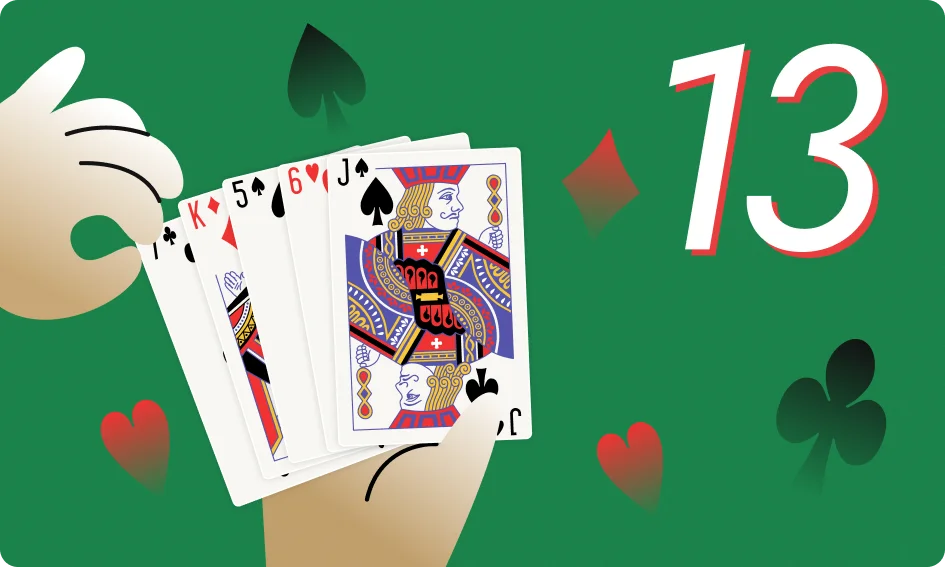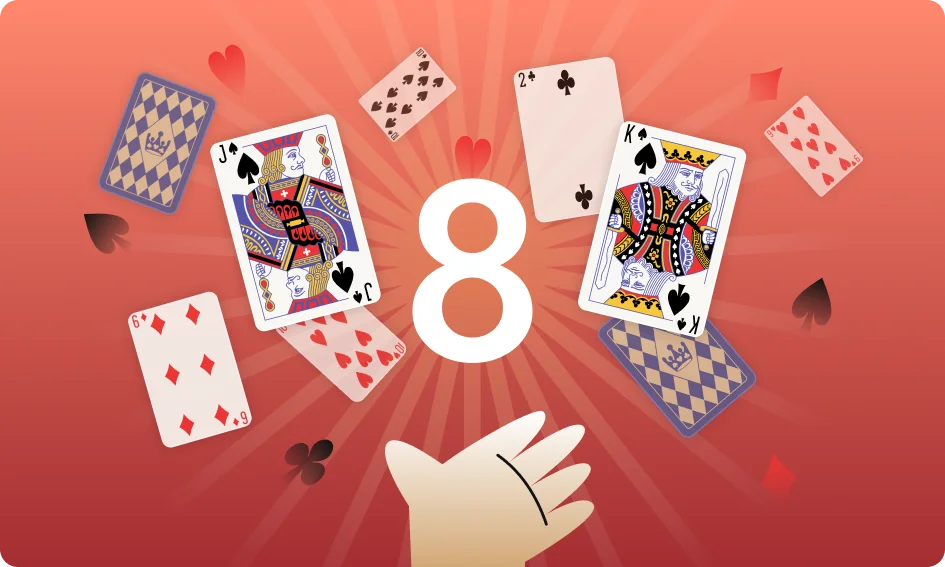The famed French mathematician Blaise Pascal once remarked, “All of humanity’s problems stem from man’s inability to sit quietly in a room alone.” This holds now more than ever. The modern world’s fast pace has made moments of solitude and quiet a rare luxury. And, when such moments do occur, they might seem dull. After all, who wants to simply sit and do nothing when there are endless shows to binge-watch on Netflix or countless reels to scroll through on Instagram?
Nonetheless, many of us find solace in card games. If this sounds like you, then know that playing cards does not just involve passing the time. You are also doing your brain a favor by working your cognitive muscles.
But, which single-player card game should you play? We’ve got a list of 13 engaging options. These can help you both escape the hustle and get rid of boredom.
1. Klondike Solitaire
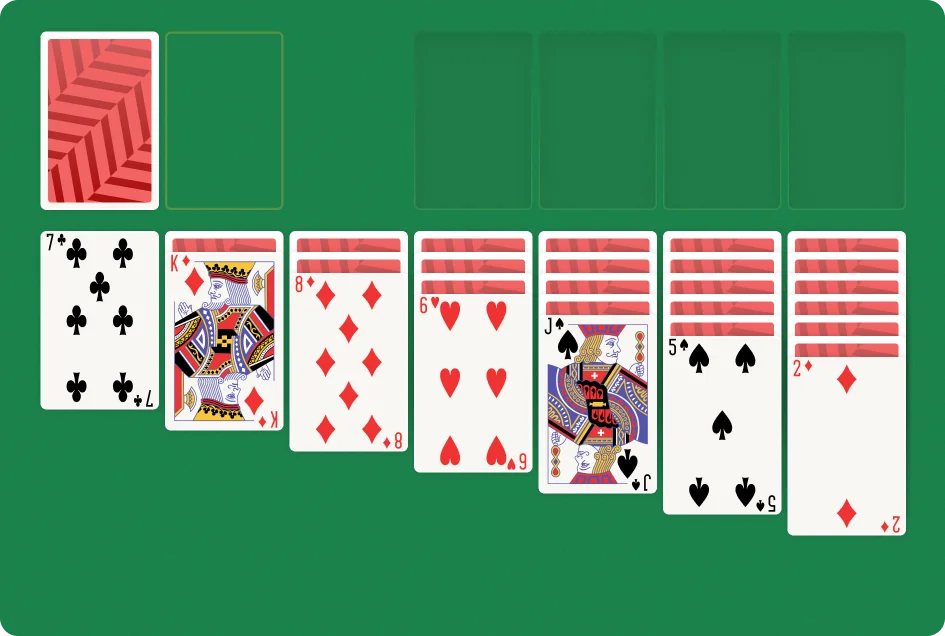
Klondike Solitaire is perhaps the most renowned variant among Solitaire card games. Indeed, it stands out as a timeless classic. With roots tracing back centuries, Klondike has been perfected over the ages into the polished version we enjoy today. Here’s how it goes.
All 52 cards are spread out on the table. Your goal is to arrange all the cards from Ace to King in the four foundation piles, each representing one of the four suits.
The name ‘Klondike’ takes me back to the computer lab of my dear old high school. That’s where I first stumbled on this game, and I’ve been hooked ever since. My journey from struggling to mastering the game’s rules served as the perfect safeguard against boredom.
There are a few rules that you’ll need to familiarize yourself with before getting started. Here’s everything you need to know about playing Klondike Solitaire.
Game Setup
- The tableau consists of seven columns, with each column increasing the number of cards (from one to seven). This means that the first column has one card, the second has two, the third has three, and so on, until you get to the seventh column, which will have seven cards.
- You must place the cards in the columns face-up.
- You then place the remaining 24 cards face-down to form the stock.
Game Rules
- Your aim is to move all four aces to the foundation as they appear. You can then begin building up each suit. You can move the top card in each tableau column to the foundation piles or another tableau pile.
- After you move a card from a column, it reveals a face-down card. You can then flip that card over.
- Cards in the tableau can be arranged in a descending sequence of alternating colors. For instance, you can pick a black five (e.g., Five of Spades) from one pile and place it on top of a red six (e.g., Six of Diamonds) in another pile.
- If you run out of desired cards or moves in your columns, then you can draw up to three cards from the stock and place them in your waste pile. You can place the top card from the waste pile on the columns or the foundations.
- The game ends when all the foundations are filled (you’ve won the game) or when no more moves can be made (you’ve lost the game).
2. Canfield Solitaire
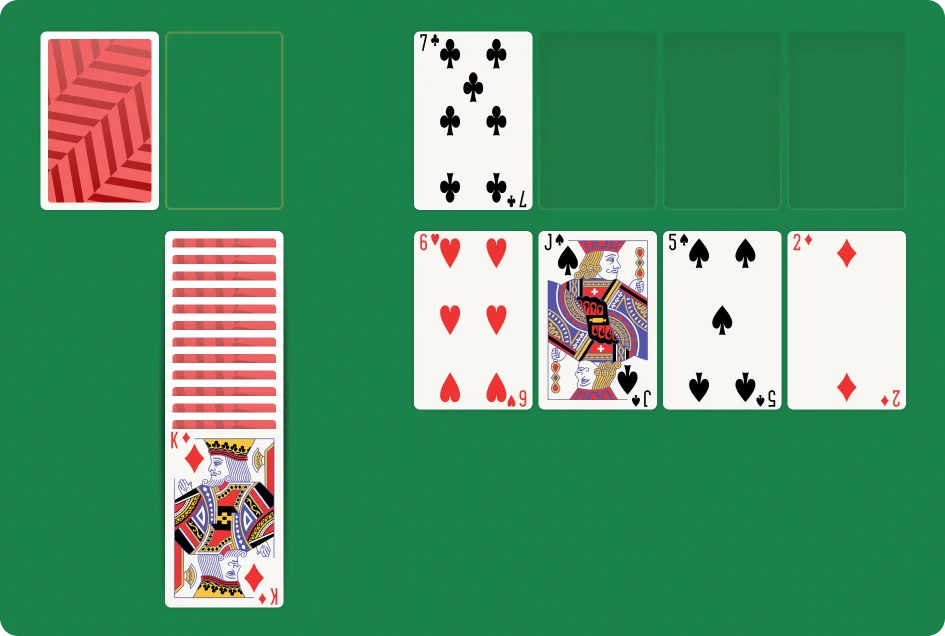
Originally known as ‘Demon Patience’, Canfield Solitaire was born in England circa the late 1800s. Thanks to a casino owner named Richard A. Canfield, the game was later introduced and popularized in the United States during the early 20th century.
Canfield had a modest run as a gambling game before ultimately falling out of fashion in that context, possibly due to its relatively long playtime compared to other flashier casino games. Outside the gambling dens, the game has, nonetheless, become a popular Solitaire option due to its challenging nature.
This variant is one of my favorite picks when I’m in the mood for a challenge. Trust me, Canfield will really fire up the neurons in your brain. Mastering this Solitaire variant is no easy feat.
Here’s a breakdown of how to play.
Game Setup
- The game begins with 13 cards dealt face-down into a pile known as the stock. The first card is, however, dealt face-up.
- The next card from the deck is placed face-up to form the first of four foundation piles.
- The next four cards are dealt face-up in a row next to the stock to form the layout.
- The remaining deck is set aside as the draw deck.
Game Rules
- The goal is to move all the cards into the four foundation piles, one for each suit.
- The first foundation pile starts with a randomly chosen card and the remaining three foundation piles start with cards of the same rank. For example, if your first foundation pile starts with a Five, then the other three will also start with a Five.
- You then build the foundation piles in ascending order, one rank at a time. When you reach the King, you continue to the Ace and beyond. So, after the King, you place an Ace, followed by a Deuce, and so on. This sequence continues until all cards are placed in the foundation piles. So, if a foundation pile starts with a Five, the sequence will be Five, Six, Seven, …, King, Ace, Deuce, Three, Four.
- Cards can be moved from the layout to the foundation piles. If there’s empty space in the layout, then you can fill it with a card from the stock or the draw deck.
- Cards from the stock can be moved directly to the foundation piles.
- Cards can be played onto the layout cards when the card being placed is one rank lower and the opposite color from the one it is being placed on.
- When playing from the deck, flip over three cards at a time. However, you can only play the top card of the flipped-over cards.
- If you manage to get all the cards into their foundation piles, then you win the game. If you get stuck with no more moves, then you lose.
3. Scorpion Solitaire
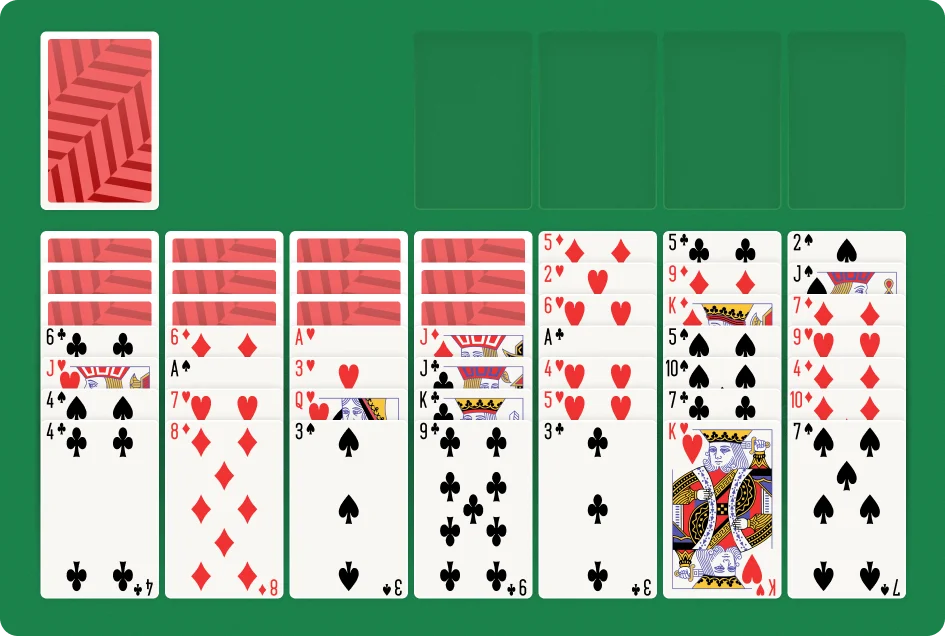
Scorpion Solitaire makes use of a standard 52-card deck but is an often overlooked Solitaire variant. Why is the game called ‘Scorpion’ Solitaire? It’s for the same reason that the Scorpius constellation in the sky is called ‘Scorpius’: They both roughly resemble the shape of a scorpion.
This game stretches your mental muscles. Scorpion Solitaire doesn’t shy away from presenting challenging situations, many of which are unwinnable. But, as you should know by now, Solitaire is not about winning every game. Part of the fun involves seeing the game unfold in front of one’s eyes, this time in the shape of a scorpion.
The only way to find out whether the cards actually make the shape of a scorpion is to play. Here’s how to do so.
Game Setup
- The cards are arranged into seven columns, each containing seven cards. The first three cards in the first four columns are placed face-down. The rest of the cards in the setup are placed face-up. They should overlap so that each card is visible.
- After the setup is complete, there will be three cards left over. Set these aside; you will use them later.
Game Rules
- The goal in the game is to move all cards into the foundation piles. Once the cards are in sequence from King down to Ace (of the same suit), you can remove them from the layout.
- Any face-up card can be moved within the layout. To move a card, it must be placed on a card that is one rank higher and the same suit. For instance, the Ten of Hearts can be moved onto the Jack of Clubs.
- When moving a card with other cards on top of it, all the cards on top of the card being moved move along with it.
- When a face-down card becomes exposed and has no cards on top of it, you can turn it over.
- When a column is empty, you can only fill it with a King.
- If you get stuck with no more moves to make, then you can add the three leftover cards from the setup to the layout. To do so, place one card face-up on each of the first three columns.
- If you get all the cards into the foundation piles, then congratulations, you’ve won the game. However, if you get stuck before this, then the game is lost.
4. Golf Solitaire
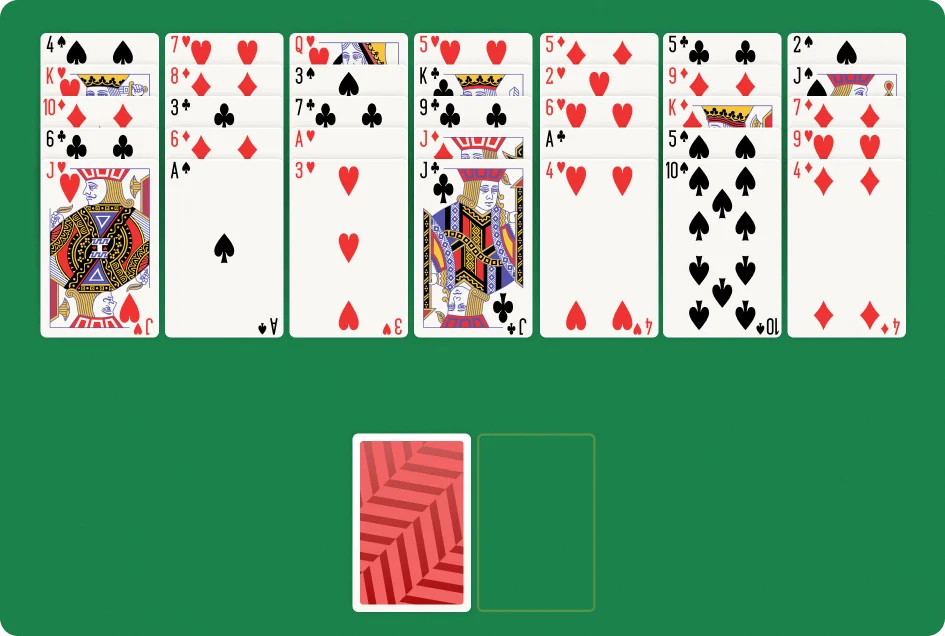
Believed to have been favored by the French in the 18th century, Golf Solitaire represents a unique twist on classic Solitaire. The game draws inspiration from the sport of golf’s scoring system; hence its name. Sounds fun, right?
I’d definitely say “yes”. Apart from classic Klondike, I’ve always found Golf Solitaire to be one of the simplest, but most enjoyable, card games to play. The fact that it has a scoring system makes it easy to measure your performance. It also keeps you motivated to try and beat your previous score.
This game has risen in popularity due to its relatively laid-back style and easy gameplay. Here’s how you can enjoy it as well.
Game Setup
- The game begins with the formation of seven columns, each containing five cards. Each subsequent row of cards overlaps with the one before it.
- The final card from the remaining deck is placed face-up to start the stock.
Game Rules
- The goal is to move all the cards into the stock. Cards can be moved to this pile if they rank higher or lower than its top card. The lower the number of moves required to achieve this, the better your score.
- The gameplay kicks off with you moving an available card to the stock (if it’s one rank higher or one rank lower than the top card). For example, a Deuce can be placed onto a Three, and a Three can be placed onto a Four.
- When no more moves can be made, flip over the top card from the remaining deck and add it to the stock.
- If you can move all the cards from the columns to the stock, then you win the game. If you get stuck, then you’ll have to try your luck on the next game.
- You can keep track of your score by adding the number of cards that are left over after each round to your total score. If you win the game and there are still cards remaining in the deck, then you deduct one point for each remaining card from your score.
5. Napoleon at St. Helena Solitaire
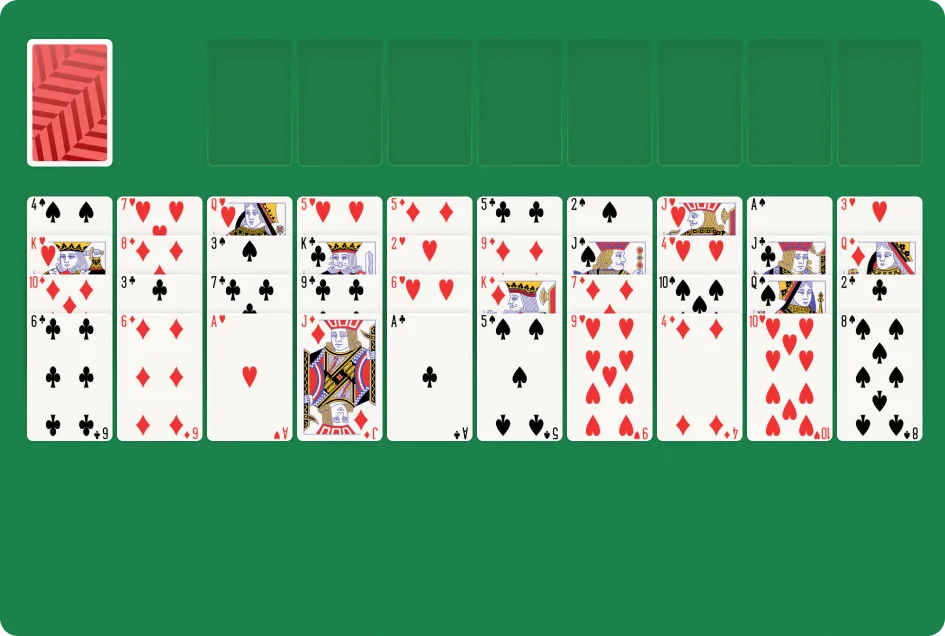
Once a mighty general, Napoleon spent the last years of his life in exile on St. Helena – a remote island in the middle of the Atlantic Ocean. What did he do in all those years away from the battlefield? Some have claimed that he used his strategic prowess to conquer this Solitaire variant.
Regardless of whether this is fact or myth, the name stuck. Napoleon at St. Helena is now one of the most popular two-deck Solitaire games out there. Trust me; you’ll want to experience the sense of command and skillfulness you get when handling double the number of cards used in standard Solitaire.
Here’s how you can play Napoleon at St. Helena.
Game Setup
- The game begins by removing all four Kings from the deck to form the King foundation piles. You can build downwards on these foundations until you eventually reach the Ace.
- You then remove the four Aces from the deck to form the Ace foundation piles. Here, the rule is the opposite – you’ll need to build up with cards of the same suit until you reach the King.
- In St. Helena, you can never have too many foundations. So, one divides the remaining cards into 12 piles of eight cards each. Four piles are placed above and four below the foundations.
- Finally, two piles of eight are placed to the right and two piles of eight to the left. In total, your tableau will have 20 piles, including the foundations.
Game Rules
- The goal in this game is to move all the cards to the foundation piles.
- The top cards can be moved to other piles provided they remain in sequence (regardless of suit). However, the ordering is not circular – you can’t place the Ace after the King.
- If you find yourself stuck with no more moves to make, then don’t worry. You haven’t lost the game. Instead, you’re allowed to redeal.
- Simply collect the piles (except for the King and Ace foundations) in the reverse order to how they were dealt. Don’t shuffle them. Stack them neatly and then redeal them into the 12 piles as before.
6. FreeCell Solitaire
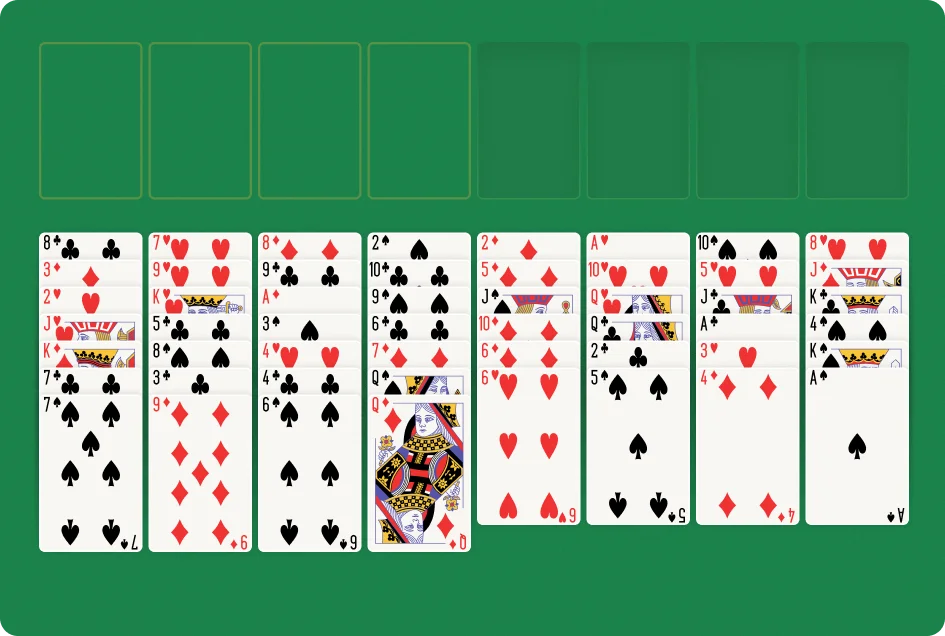
FreeCell Solitaire is one of the most popular variants of classic Klondike. It is a relatively recent creation, one whose origins trace back to the 1970s, when it was created as a computer game. Soon, anyone with a Windows operating system had either played or at least heard of this game.
If Klondike has lost a bit of its charm for you, then I suggest switching to Freecell. This game will not only present you with a refreshing take on Solitaire. It also adds an extra level of difficulty, which is, perhaps, just what your previous games were lacking!
To start playing, all you need to do is understand the following simple rules.
Game Setup
- The game starts off by forming eight columns. The cards are distributed face-up among these columns, with the first four columns containing one more card than the last four.
- There are four ‘free cells’, which can temporarily hold a single card. When possible, you can move this card back to a column from the free cell.
Game Rules
- The goal is simply to arrange all the cards in the four foundation piles.
- Within the eight columns, you can move a card onto another card if the card you are moving is one rank lower and a different color from the card you place it on.
- Cards can only be moved to their respective foundation pile in ascending order (starting with the Ace and ending with the King).
- The game is won if you successfully move all the cards to the four foundation piles.
7. Pyramid Solitaire
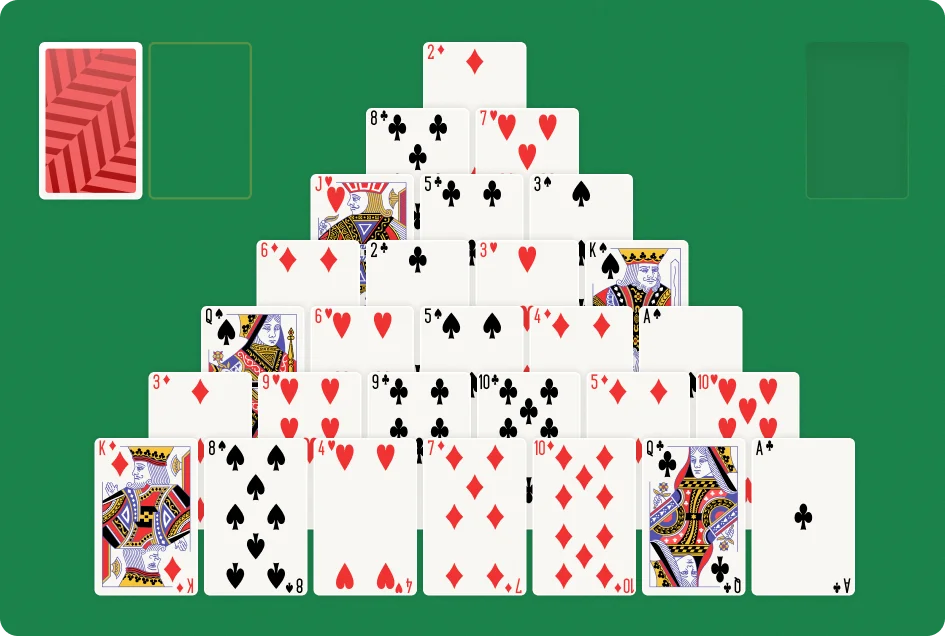
Named after the unique pyramid shape that the card setup forms, Pyramid Solitaire has been around for about 200 years. However, it wasn’t introduced on a large scale until the 1940s when “The Complete Book of Solitaire and Patience Games” came out. When Windows decided to adopt this version, its popularity soared.
I love this game mostly due to its visual appeal. There’s no way one can see the pyramid of cards set up on the tableau without being drawn to it. After all, whether they’re standing in Egypt, featured in movies, or in a game of Solitaire, pyramids have a universal appeal, one that’s hard to resist.
Here’s a quick rundown of the game.
Game Setup
- The cards are arranged in a pyramid shape starting from the top. The first row has one card, the second has two cards, and so on until the seventh, which has seven cards. So, you use a total of 28 cards for the pyramid. note also that the rows must overlap slightly.
- After setting up the pyramid, the remaining cards form the stock. This pile is kept face-down.
Game Rules
- The main objective is to remove all the cards from the pyramid. The cards are removed in pairs such that the sum of their values is 13. This means that you can remove an Eight and a Five together but not an Eight and a Four.
- A King can be removed by itself without forming any pair.
- Removed cards form a discard pile.
- Cards from the stock can also be flipped face-up and paired with cards from the pyramid.
- If you flip up a card from the stock and find no suitable pair for it, then you can place it in the waste pile.
- If you remove all the cards from the pyramid, then you win the game.
8. Spider Solitaire
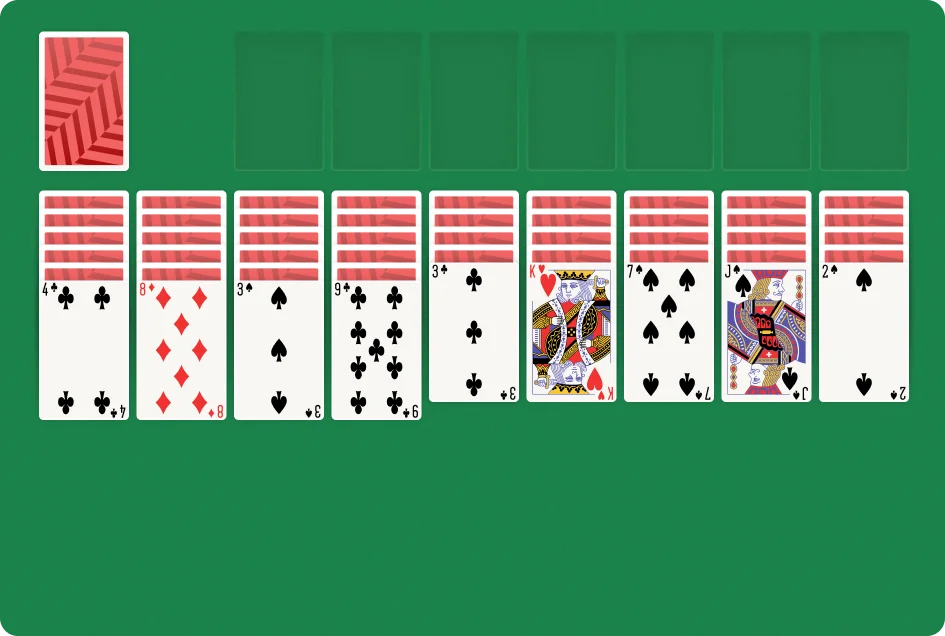
Another game named after an arachnid! Spider Solitaire is a popular two-deck Solitaire variant. The game is named ‘Spider’ Solitaire because it features eight foundation piles – a reference to the eight legs spiders have.
I must admit that for the longest time, I avoided this Solitaire variant. My hesitation was mostly due to a mistaken presumption that it was extraordinarily tough to play. If you find yourself in a similar position, then let me assure you that there’s no need to be hesitant. With a bit of patience and practice, it becomes as straightforward and fun as any other Solitaire game (well, sort of).
The game has three levels of difficulty. For the sake of simplicity, I’ll describe the easiest version of the game, where you don’t have to worry about suits. Here’s everything you need to familiarize yourself with this fascinating variant.
Game Setup
- Shuffle two decks of cards together. Then, lay out 10 cards face-down in a horizontal row. Repeat this three more times, with each row slightly overlapping the previous one.
- Add one more card to the first four columns.
- After that, you can turn the top cards from each of the 10 columns over.
- The remaining deck forms the stock.
Game Rules
- The goal is to create sequences of cards within a column in descending order (from King to Ace). Once you complete a sequence, you can remove those cards from the game.
- You can move face-up cards onto other cards as long as the card being moved is one rank lower than the card you place it on.
- When you move a card, the face-down card it reveals can be flipped over.
- Any card or sequence of cards can be moved to an empty column.
- If you have no more moves to make, then you can bring in a new row of cards from the stock. When doing so, place one face-up card on each column.
- You win the game when you have all the cards in sequence and remove them from the tableau.
9. Accordion Solitaire
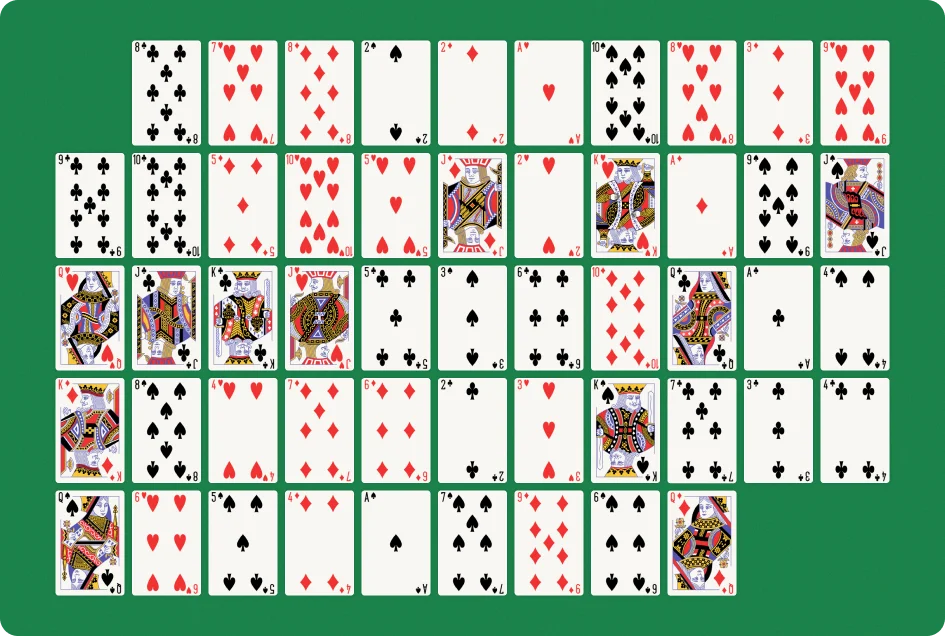
With a rich history dating back to the late 19th century, Accordion Solitaire is perhaps the most unique game on this list. It is cleverly named after the accordion because the layout seems to grow and shrink during gameplay (just like the musical instrument).
This game is a blast. In fact, Accordion Solitaire has helped me keep my mind occupied (and sane) through some tough times in my life (which I won’t go into here).
Here’s how you can get started.
Game Setup
- Grab your trusty deck of 52 cards, shuffle, and begin playing.
- Accordion Solitaire does not have any specific setup because it’s played directly from the deck in hand.
Game Rules
- The objective in this game is to put the cards in a horizontal row (so, if you’re playing on a table, then you’ll need to manage your space).
- Every time you want to place a new card, check whether you can stack it on top of any of the cards to its left. A simple rule governs this action: one step to the left or three steps to the left. What this means is that you can only stack your card on the card immediately to the left or three cards to the left of it. Let’s say that you have a row containing a Deuce of Spades, Seven of Hearts, Eight of Clubs, and Ace of Hearts. You then draw a King of Hearts. Now, you can only place it on the Ace of Hearts (one step to the left) or on the Seven of Hearts (three steps to the left).
- Another rule is that you can only pair cards if they have the same suit or the same rank. This means that a Queen of Spades can only be paired with (e.g.) a Queen of Hearts (same rank) or (e.g.) a Six of Spades (same suit).
- You win the game if you can reduce the row into just one pile to the left.
10. Grandfather Clock Solitaire
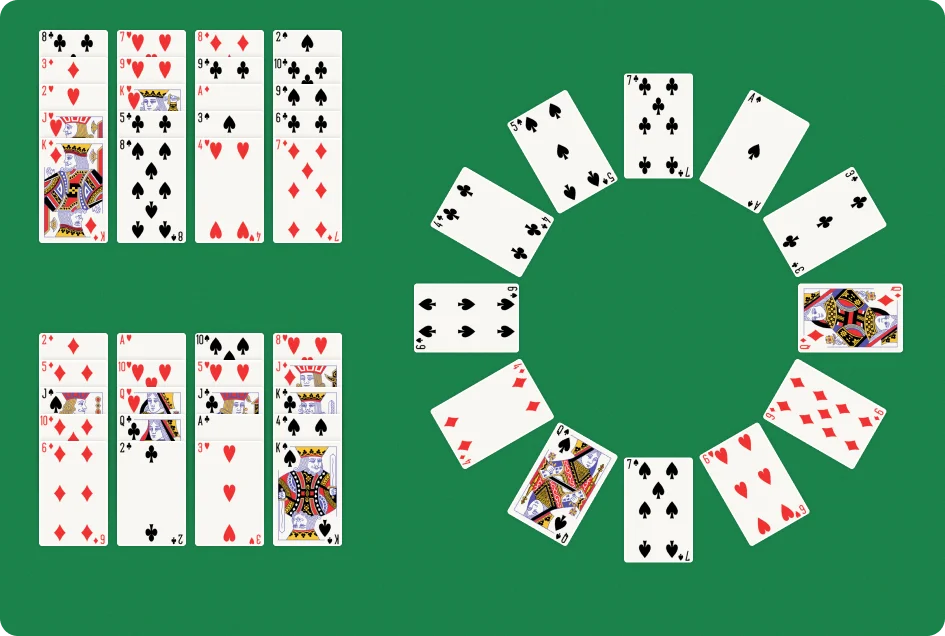
Resembling the shape of an actual clock, Grandfather Clock Solitaire is one of the most visually appealing Solitaire variants. But, don’t be fooled by its looks. It’s considered to be a very strategic game. It requires lots of practice to learn the right time to make the right moves.
Nonetheless, I love playing this game due to the amount of control it gives one in setting up the game. Unlike many other Solitaire variants – where the deal largely determines the outcome – this game always has the same initial setup.
Here’s what you can expect from this game.
Game Setup
- The game is set up by selecting very specific cards from the deck: Deuce of Hearts, Three of Spades, Four of Diamonds, Five of Clubs, Six of Hearts, Seven of Spades, Eight of Diamonds, Nine of Clubs, Ten of Hearts, Jack of Spades, Queen of Diamonds, and King of Clubs.
- These selected cards are placed in the foundation. Instead of placing them in a 1 to 12 sequence (as in Clock Solitaire), you must follow a different sequence. Place the Nine where the 12 would be on a clock and the Six where the 9 would be. Fill in the rest of the selected cards to complete the sequence.
- Now, deal out the rest of the deck in the form of five rows of eight face-up cards each. This is your tableau, and you can place cards in descending order (regardless of suit) to arrange or reveal cards.
Game Rules
- The objective in this game is to align the sequence in the foundation with the sequence of an actual clock.
- You can only place cards of the same suit on the cards in the foundation.
- You can move the necessary cards to the foundation until you match the position on a clock. For example, the Nine of Clubs corresponds to 12 on the clock. So, your goal is to place the Ten of Clubs, Jack of Clubs, and the Queen of Clubs on top of it.
- Only the topmost cards in the tableau can be moved to the foundation. Hence, to access the necessary cards in the tableau, you can move the topmost card of one pile to another as long as it is one rank lower, regardless of suit.
- You win the game when all the cards are in sequence with the positions on a clock.
11. TriPeaks Solitaire
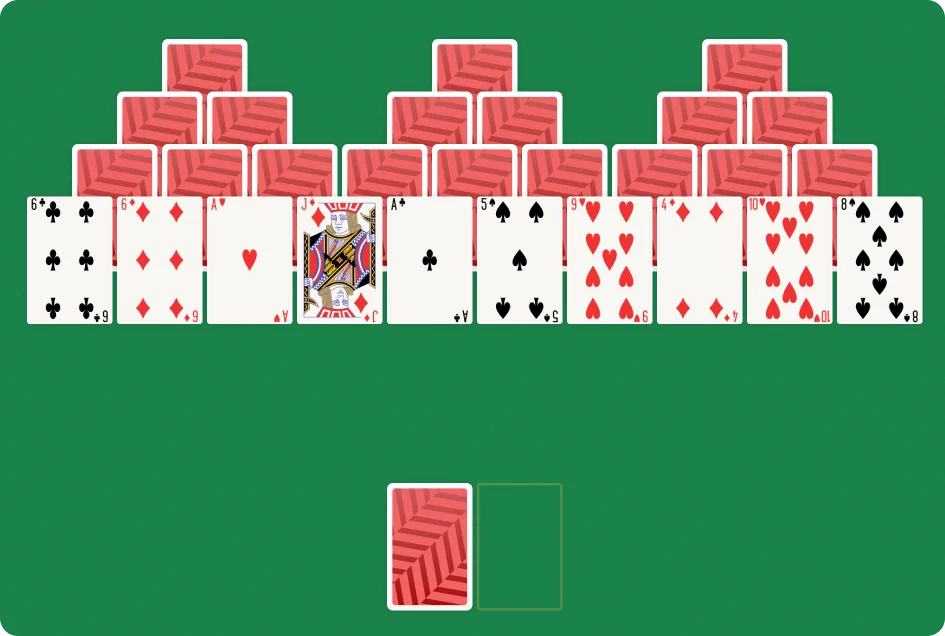
If you like the idea of playing Pyramid Solitaire, then you’ll love a Solitaire game with three pyramids! Invented in the 1980s, TriPeaks Solitaire has gained a fan base after its inclusion in the Microsoft Solitaire Collection.
As a proud member of this fanbase, I’d be happy to induct you as well. This variant’s appeal might be difficult to gauge at first, but I guarantee that it’ll end up becoming one of your favorites.
To join the TriPeaks community, you’ll first need to learn the setup and rules.
Game Setup
- To begin, you must place three cards face-down to form the three peaks. Then, place two cards face-down, slightly overlapping each of the three peak cards. Next, place three cards face-down, slightly overlapping those in the previous row. Finally, place a row of four face-up cards for the base of the pyramids. As before, these should slightly overlap the cards in the previous row.
- The remaining deck stays face-down.
- Flip the top card from this deck face-up and place it in the discard pile.
Game Rules
- The goal is to move all the cards from the TriPeaks layout into your discard pile.
- A card can be moved from the layout into the discard pile if the card being moved ranks higher or lower than the top card in the discard pile.
- An Ace can be placed on a King or a Deuce.
- If a face-down card no longer has any cards overlapping it, then you can flip it over.
- When no more cards from the layout can be discarded, you can move the top card from the stock onto the discard pile.
- The game is won if you can get all the cards from the TriPeaks into the discard pile.
12. Windmill Solitaire
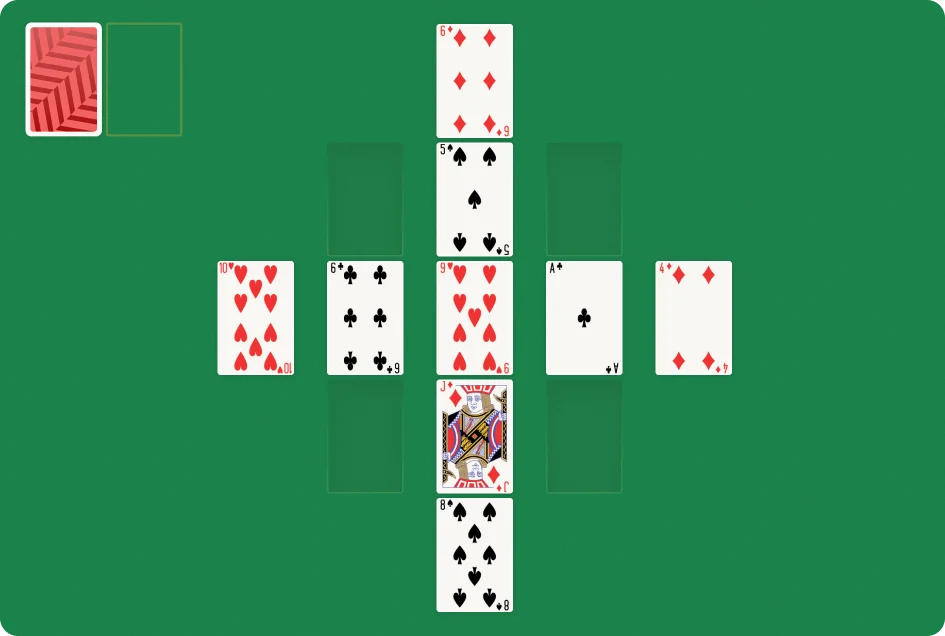
Windmill Solitaire makes use of two decks (so a total of 104 cards). This variant’s intriguing gameplay be might just the gust of fresh air you’ve been looking for. The game’s initial layout has an uncanny resemblance to a windmill’s sails; hence the name.
The game’s rules are pretty straightforward. I’ve always found Windmill Solitaire to be the perfect blend of challenge and fun. While it can be a bit intimidating to look at initially, I am confident that you’ll soon be hooked. One experiences a real sense of satisfaction each time one retires a foundation deck.
Here’s everything you need to know about Windmill Solitaire.
Game Setup
- Start by selecting an Ace from the deck and placing it in the center. This forms the Ace foundation. You need to build on this foundation four times (regardless of suit). The goal is to eventually have 52 cards piled up in it.
- When dealing out your tableau, place two cards above the Ace, two cards below, two cards on the left, and two cards to the right. These eight cards form the reserve.
- If you come across Kings during the game, place them on the corners to form the four King foundations. Your job is to place cards in descending order (King to Ace) on the King foundations (regardless of suit).
Game Rules
- Your aim is to reduce the ‘Windmill’ into the Ace foundation piles and King foundation piles.
- The gameplay involves moving cards from the eight-card reserve to these foundations.
- If you draw a card with no possible combination, then you can place it on the waste pile. The top card in the waste pile is in play and can be used to replenish the reserves.
- You can use the top card from a King foundation to build up an Ace foundation (if necessary).
- If you’ve already used a King in the eight-card reserve, move it from there to a corner to form a foundation. You can then replenish the empty space from the deck.
- The game is won when all the cards are in the Ace and King foundations.
13. Beehive Solitaire
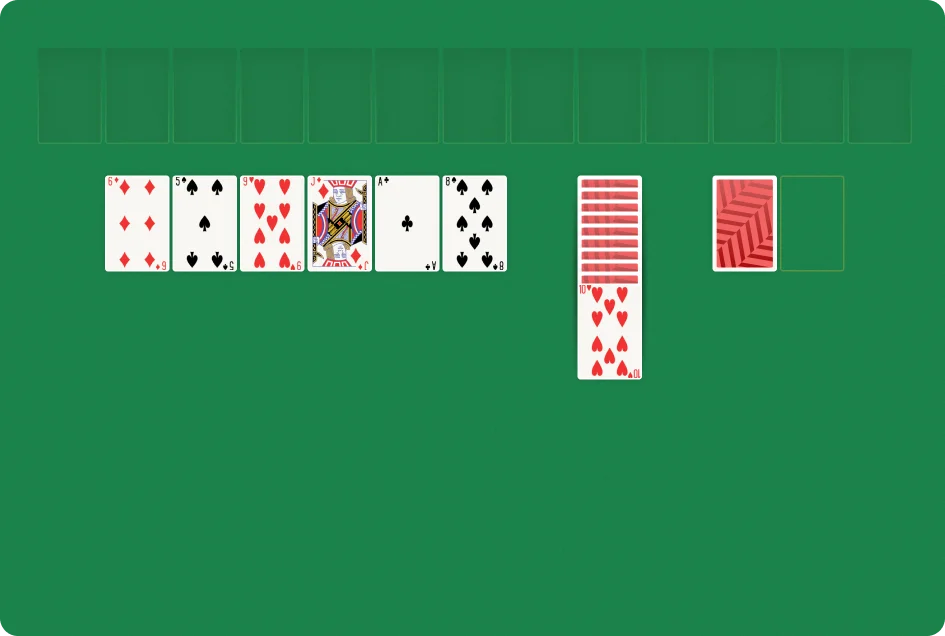
In Beehive Solitaire, the layout resembles the home of our little honey-making friends. Its unique, yet challenging, gameplay has kept many players engrossed for hours at a time.
Beehive Solitaire can present quite a challenge to new players. You might not get the hang of it immediately, but don’t let that dishearten you. I was in the same shoes not long ago. Trust me when I say that you’ve got to give this variant a try.
The goal is to build piles of four until the entire deck has been used up. This process is governed by some very interesting rules, which I have summarized here.
Game Setup
- The game’s setup begins by stacking ten cards face-up. This stack is known as the ‘Beehive’.
- Next, lay out six cards face-up in two rows of three cards to form the layout.
Game Rules
- The goal is to group all the cards into sets of four with matching ranks (regardless of suit).
- To start the game, you must make any available matches within the six-card layout.
- When there’s an open space in the layout, fill it in with the top card from the Beehive.
- After available matches are made (within the layout and using the Beehive), the remaining deck comes into play. Take out three cards and place them face-up into the waste pile.
- The top card in the waste pile can be added to the layout. If not, then you can draw another three cards from the deck.
- Cards can be moved within the six-card layout, brought in from the Beehive, or from the waste pile.
- Once you’ve made a group of four cards with the same rank, you can remove that group from the layout. The open space is filled with the top card from the Beehive.
- When you can’t make any more moves, simply flip the waste pile back over to the deck and redeal it.
- After the Beehive has been exhausted, you can fill open spaces in the layout with the top card from the waste pile.
- The game is won when every card in the deck is grouped into a set of four.
Conclusion
Solitaire is about as diverse as a game can be. There seem to be more variations than one can count. The 13 single-player card games I’ve recommended here barely scratch the surface. Whether you’re a newbie looking for a fun way to pass the time or a veteran with loads of Solitaire games under your belt, we’ve got you covered. There’s absolutely no room for boredom when you’re playing Solitaire.

